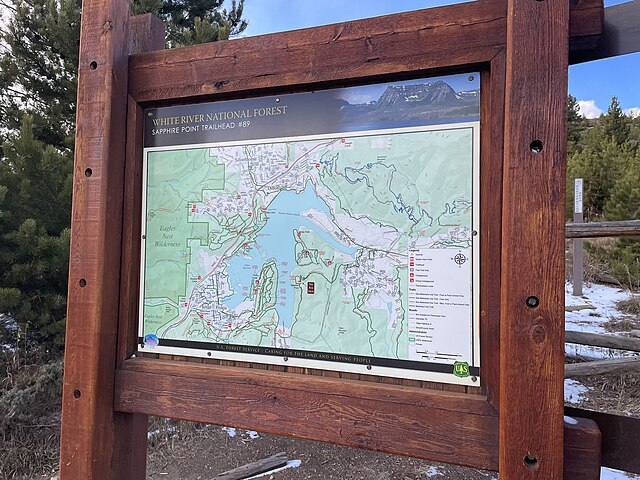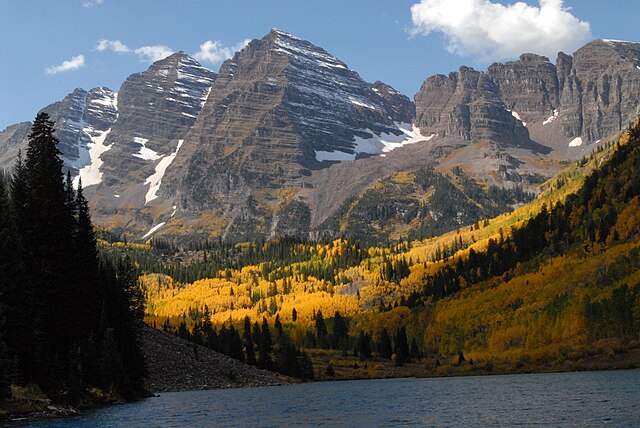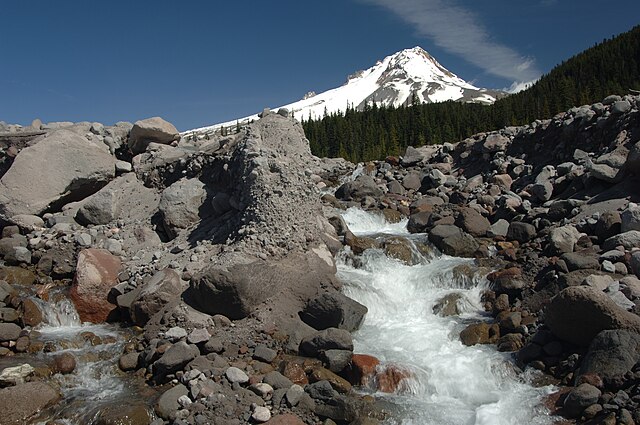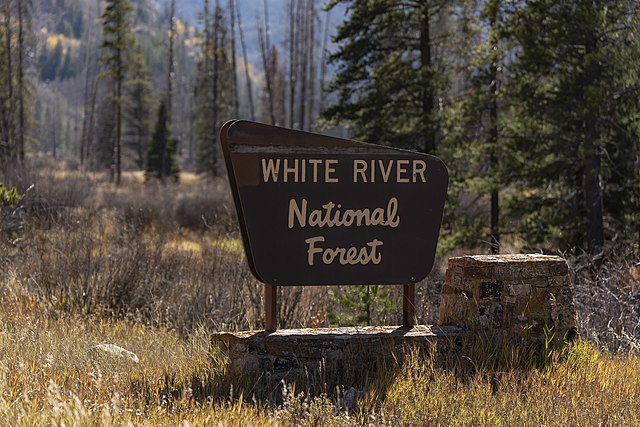Have you ever wondered where Colorado keeps its most spectacular natural treasures? Look no further than White River National Forest – a sprawling wilderness paradise that’s captured the hearts of outdoor enthusiasts for generations. Whether you’re seeking heart-pumping adventures or peaceful moments in nature, this incredible forest offers something magical for everyone.
What Makes White River National Forest Special?
White River National Forest isn’t just another pretty face in Colorado’s crown of natural wonders. It’s actually the most visited national forest in the entire United States, and once you experience its breathtaking beauty, you’ll understand why millions of people make the pilgrimage here each year.
Location and Size Overview
Spanning an impressive 2.3 million acres across west-central Colorado, White River National Forest is like nature’s own theme park – except the rides are mountains, and the entertainment is pure wilderness bliss. The forest stretches across multiple counties, including Eagle, Garfield, Lake, Pitkin, and Summit counties, creating a diverse tapestry of landscapes that’ll leave you speechless.
Think of it this way: if Colorado is America’s playground, then White River National Forest is the crown jewel of that playground. It’s home to eight designated wilderness areas, including the famous Maroon Bells-Snowmass Wilderness and the Holy Cross Wilderness. These protected areas ensure that future generations will experience the same unspoiled beauty we’re privileged to enjoy today.
Unique Ecosystem and Wildlife
What sets White River National Forest apart isn’t just its size – it’s the incredible diversity of life it supports. From alpine meadows bursting with wildflowers to dense aspen groves that paint the mountainsides gold each fall, this forest is nature’s masterpiece in motion.
The elevation changes dramatically throughout the forest, ranging from around 6,000 feet to over 14,000 feet at some of the highest peaks. This elevation diversity creates distinct ecological zones, each supporting different plant and animal communities. You might spot elk grazing in mountain meadows, black bears foraging for berries, or mountain goats navigating seemingly impossible cliff faces.
The forest is home to several “fourteeners” (peaks over 14,000 feet), including the iconic Maroon Bells, often called the most photographed mountains in North America. These towering sentinels aren’t just pretty faces – they’re geological storytbooks that tell the tale of Colorado’s dramatic formation over millions of years.
Planning Your Visit to White River National Forest

Planning a trip to White River National Forest is like preparing for the adventure of a lifetime. But don’t worry – with the right information, you’ll be ready to make the most of every moment in this wilderness wonderland.
Best Time to Visit
Here’s the million-dollar question: when should you visit White River National Forest? The answer depends entirely on what adventure you’re seeking. Each season offers its own unique magic, like different chapters in an epic novel.
Summer (June through August) is peak season for good reason. The weather is warm, most trails are accessible, and the wildflowers are putting on their annual show. However, this popularity comes with crowds, so if you prefer solitude, consider visiting during shoulder seasons.
Fall (September through October) might just be the forest’s most spectacular season. The aspen trees transform into golden torches, creating one of nature’s most breathtaking displays. The weather is crisp but comfortable, and the summer crowds have thinned out considerably.
Winter transforms White River National Forest into a snow-covered wonderland perfect for skiing, snowshoeing, and winter photography. Popular ski resorts like Aspen, Vail, and Snowmass operate within the forest boundaries.
Spring (April through May) can be unpredictable, with snow still covering higher elevations while lower areas begin to green up. It’s a season of transition that offers unique opportunities for those willing to be flexible with their plans.
Entry Requirements and Permits
Unlike national parks, White River National Forest doesn’t charge an entry fee for basic access. However, certain activities require permits, and understanding these requirements ahead of time will save you headaches later.
Camping Permits and Reservations
Developed campgrounds within White River National Forest operate on a reservation system, especially during peak summer months. Think of these reservations like tickets to the hottest concert in town – they go fast, so book early through Recreation.gov.
For those seeking a more primitive experience, dispersed camping is allowed in most areas of the forest without permits. However, you must follow Leave No Trace principles and camp at least 100 feet from water sources and established trails.
Hiking and Backcountry Permits
Most day hiking in White River National Forest doesn’t require permits, but there are exceptions. Some popular areas like the Maroon Bells require advance reservations during peak season (mid-June through early October) and charge a modest fee for vehicle access.
Overnight backcountry camping in designated wilderness areas requires permits, which are free but limited in number. These permits help protect fragile ecosystems while ensuring backcountry users have quality wilderness experiences.
Top 10 Must-Do Activities in White River National Forest
White River National Forest is like an all-you-can-eat buffet of outdoor adventures. Here are the activities that absolutely deserve a spot on your bucket list.
Hiking and Backpacking Adventures
With over 2,500 miles of trails, White River National Forest offers hiking opportunities for every skill level and interest. From gentle nature walks to challenging peak ascents, the trail system reads like an adventure novel with endless plot twists.
Maroon Bells Scenic Loop
The Maroon Bells Scenic Loop is probably the most iconic hike in all of Colorado, and for good reason. This relatively easy 1.5-mile loop around Maroon Lake offers postcard-perfect views of the famous Maroon Bells peaks reflected in the crystal-clear alpine lake.
The trail is accessible to most fitness levels, making it perfect for families or anyone wanting to experience the forest’s beauty without extreme physical demands. Early morning visits offer the best lighting for photography and smaller crowds.
Capitol Peak Challenge
For experienced mountaineers seeking the ultimate challenge, Capitol Peak stands as one of Colorado’s most technical fourteeners. This isn’t a casual day hike – it’s a serious mountaineering endeavor that requires technical climbing skills, proper equipment, and excellent physical conditioning.
The “Knife Edge” ridge near the summit is legendary among Colorado climbers, offering both breathtaking exposure and heart-stopping views. Only attempt this climb if you have extensive mountaineering experience and are comfortable with significant exposure.
Winter Sports and Snow Activities
When snow blankets White River National Forest, it transforms into a winter sports paradise that rivals anywhere in the world. The forest encompasses several world-class ski resorts, but the backcountry skiing and snowshoeing opportunities are equally impressive.
Cross-country skiing and snowshoeing trails wind through silent aspen groves and across snow-covered meadows, offering peaceful alternatives to the bustle of downhill ski areas. Many summer hiking trails become excellent winter routes for those with proper winter travel skills.
Fishing and Water Sports
White River National Forest’s pristine streams, rivers, and alpine lakes offer some of Colorado’s finest fishing opportunities. The White River itself, along with the Roaring Fork River and numerous tributary streams, provide excellent trout fishing in stunning mountain settings.
Lake fishing opportunities abound, from easily accessible roadside lakes to remote alpine tarns that require significant hiking to reach. Each offers its own character and fishing challenges, from brook trout in high alpine lakes to larger brown and rainbow trout in lower elevation waters.
Best Camping Spots in White River National Forest

Choosing where to camp in White River National Forest is like picking your favorite star in the night sky – there are so many brilliant options that the choice can feel overwhelming. Let’s break down your options to help you find the perfect basecamp for your adventures.
Developed Campgrounds vs. Dispersed Camping
White River National Forest offers both developed campgrounds with amenities and dispersed camping for those seeking a more primitive experience. Developed campgrounds provide picnic tables, fire rings, and restrooms, while dispersed camping offers solitude and flexibility.
Popular developed campgrounds like Maroon Lake Campground and Difficult Campground fill up quickly during peak season. These campgrounds offer the convenience of established facilities while keeping you close to major trailheads and attractions.
Dispersed camping allows you to create your own private campsite almost anywhere in the forest, following established guidelines. This option appeals to those who want to escape crowds and truly immerse themselves in the wilderness experience.
Family-Friendly Camping Options
Families with children will appreciate campgrounds like White River Campground and Weller Campground, which offer level sites, clean facilities, and easy access to family-appropriate activities. These campgrounds often feature interpretive programs and nature walks designed specifically for young adventurers.
Many family-friendly campgrounds are located near streams or lakes, providing natural entertainment for kids while giving parents peace of mind about water safety. The sound of flowing water also creates a natural white noise machine for better sleep under the stars.
Wildlife Watching and Photography Tips
White River National Forest is like a living, breathing nature documentary, and you have front-row seats to the show. The diversity of wildlife here is absolutely staggering, from massive elk to tiny pikas that live among the rocks above treeline.
Best Wildlife Viewing Locations
Early morning and late evening are prime times for wildlife viewing, when animals are most active and lighting is optimal for photography. The forest’s many meadows and water sources serve as natural gathering places for wildlife.
Elk are perhaps the forest’s most iconic residents, and fall rutting season (September through October) offers spectacular viewing and listening opportunities. The haunting bugle calls of bull elk echoing across mountain valleys create memories that last a lifetime.
Mountain goats inhabit the highest, most rugged terrain in the forest, and spotting them requires patience and often significant hiking. However, the reward of seeing these sure-footed athletes navigating seemingly impossible terrain is worth every step.
Photography Ethics and Guidelines
Responsible wildlife photography means respecting both the animals and their habitat. Maintain safe distances from all wildlife – use telephoto lenses rather than approaching animals for closer shots. Remember that your safety and the animals’ wellbeing are more important than any photograph.
The forest’s dramatic landscapes provide endless photography opportunities beyond wildlife. The changing light throughout the day transforms familiar scenes into entirely new compositions, rewarding photographers who take time to explore different lighting conditions.
Safety Tips for White River National Forest
Adventure and safety aren’t mutually exclusive – in fact, proper safety preparation enhances your ability to fully enjoy everything White River National Forest has to offer. Think of safety planning as your insurance policy for amazing adventures.
Weather Preparedness
Mountain weather can change faster than a teenager’s mood, and being prepared for these changes is crucial for safe outdoor adventures. Even summer days can bring afternoon thunderstorms with dangerous lightning, while clear mornings might give way to snow at higher elevations.
Layer your clothing system like you’re building a house – start with moisture-wicking base layers, add insulating layers as needed, and top with wind and waterproof outer layers. This system allows you to adapt to changing conditions throughout the day.
Always check weather forecasts before heading out, but remember that mountain weather can be highly localized and forecasts aren’t always accurate. Carry emergency shelter and extra layers even on apparently perfect days.
Wildlife Safety Guidelines
Sharing the forest with wildlife requires respect, awareness, and proper precautions. Most wildlife encounters are thrilling and safe, but understanding animal behavior and maintaining appropriate distances protects both you and the animals.
Black bears are present throughout White River National Forest, and proper food storage is essential whether you’re camping or just enjoying a trail lunch. Use bear-proof containers or hang food at least 12 feet high and 4 feet from tree trunks.
Mountain lions inhabit the forest but are rarely seen due to their elusive nature. If you encounter a mountain lion, maintain eye contact, appear large by raising your arms, and back away slowly while making noise.
Getting There: Transportation and Access Points

White River National Forest’s size and scope mean multiple access points serve different areas of the forest. Planning your approach based on your intended activities will save time and enhance your overall experience.
Major Access Routes
Interstate 70 provides the primary east-west access to White River National Forest, with exits leading to popular destinations like Vail, Copper Mountain, and Keystone. Highway 82 leads south from I-70 to the famous Aspen area and Maroon Bells.
From the south, Highway 24 and Highway 91 provide access to areas around Leadville and the Sawatch Range. These southern approaches often receive less traffic than the I-70 corridor, making them attractive alternatives during peak visitation periods.
Parking and Transportation Tips
Popular destinations within White River National Forest can experience severe parking shortages during peak times. Arriving early (before 8 AM) dramatically improves your chances of finding parking at popular trailheads like Maroon Bells.
Some areas offer shuttle services during peak season to reduce traffic congestion and environmental impact. The Maroon Bells area, for example, requires reservations and operates a shuttle system during busy periods.
Nearby Attractions and Towns
White River National Forest doesn’t exist in isolation – it’s surrounded by charming mountain towns and additional attractions that can enrich your Colorado adventure. These communities offer dining, lodging, and cultural experiences that complement your forest adventures.
Aspen combines world-class outdoor recreation with sophisticated dining, shopping, and cultural attractions. The town’s Victorian architecture and vibrant arts scene provide pleasant contrasts to wilderness experiences.
Vail offers similar amenities with a distinctly European alpine atmosphere. The town’s pedestrian village and extensive trail system make it an excellent base for exploring the northern sections of White River National Forest.
Smaller communities like Carbondale, Basalt, and Marble offer more affordable lodging options while maintaining easy access to forest activities. These towns often provide more authentic local experiences and insider knowledge about hidden gems within the forest.
Conclusion
White River National Forest stands as one of America’s greatest natural treasures, offering an incredible diversity of experiences within its 2.3 million acres of pristine wilderness. From the iconic Maroon Bells to hidden alpine lakes, from family-friendly campgrounds to challenging fourteener climbs, this forest truly offers something magical for every outdoor enthusiast.
Whether you’re planning a weekend camping trip or a weeks-long backcountry adventure, White River National Forest rewards visitors with memories that last a lifetime. The key to a successful visit lies in proper planning, respect for the natural environment, and openness to the unexpected discoveries that await around every bend in the trail.
As you plan your own White River National Forest adventure, remember that this incredible landscape exists for all of us to enjoy responsibly. By following Leave No Trace principles and treating the forest with the respect it deserves, we ensure that future generations will experience the same wonder and inspiration that draws millions of visitors here each year.
Frequently Asked Questions
1. Do I need reservations to visit Maroon Bells?
Yes, during peak season (mid-June through early October), you need advance reservations to drive to Maroon Bells. Reservations can be made through Recreation.gov and include a modest fee. Walk-in access and shuttle services are also available during this period.
2. What’s the best time of year to see fall colors in White River National Forest?
Peak fall colors typically occur from mid to late September, though timing varies with elevation and weather conditions. Aspen trees provide the most dramatic color displays, turning brilliant gold against the backdrop of evergreen forests and snow-capped peaks.
3. Are pets allowed in White River National Forest?
Yes, pets are generally allowed in White River National Forest but must be kept on leashes in developed areas and under voice control in backcountry areas. Some specific areas may have additional restrictions, so check current regulations for your intended destination.
4. How difficult are the hiking trails in White River National Forest?
Trail difficulty ranges from easy nature walks suitable for families to extremely challenging mountaineering routes requiring technical skills. Most popular trails are well-marked with difficulty ratings, and ranger stations provide current trail conditions and recommendations based on your experience level.
5. What should I do if I encounter a bear while hiking?
If you encounter a black bear, avoid direct eye contact, make yourself appear large by raising your arms, speak calmly while slowly backing away, and make noise. Never run from a bear or approach it. Most bear encounters end peacefully when humans give bears space to retreat.

